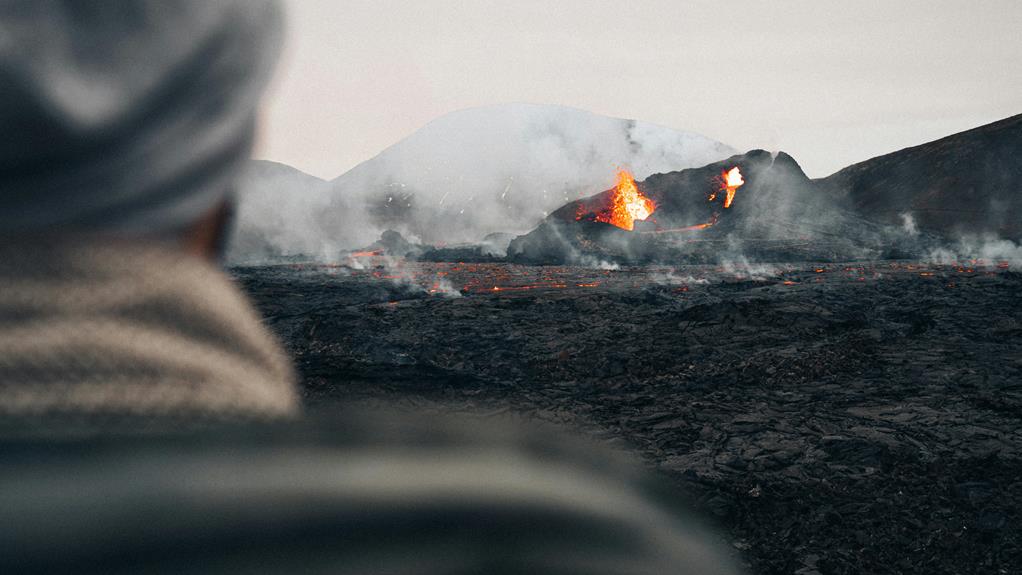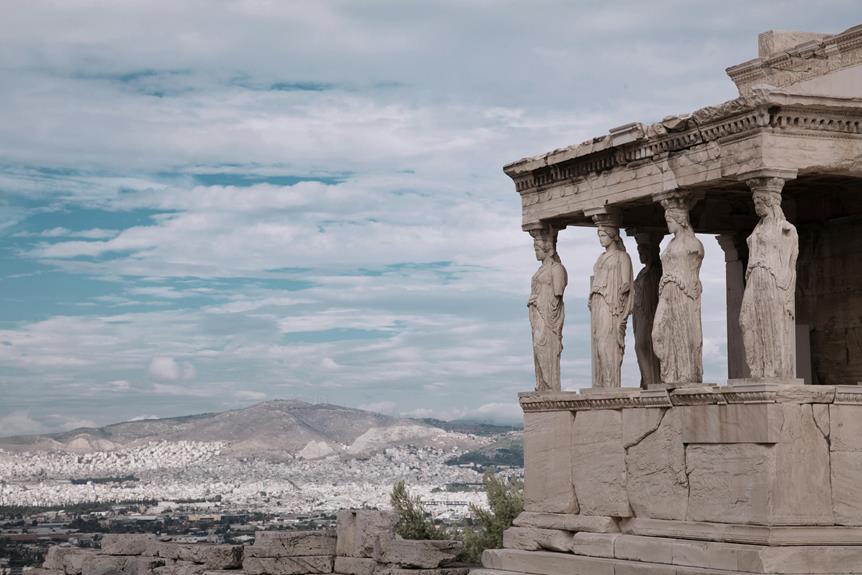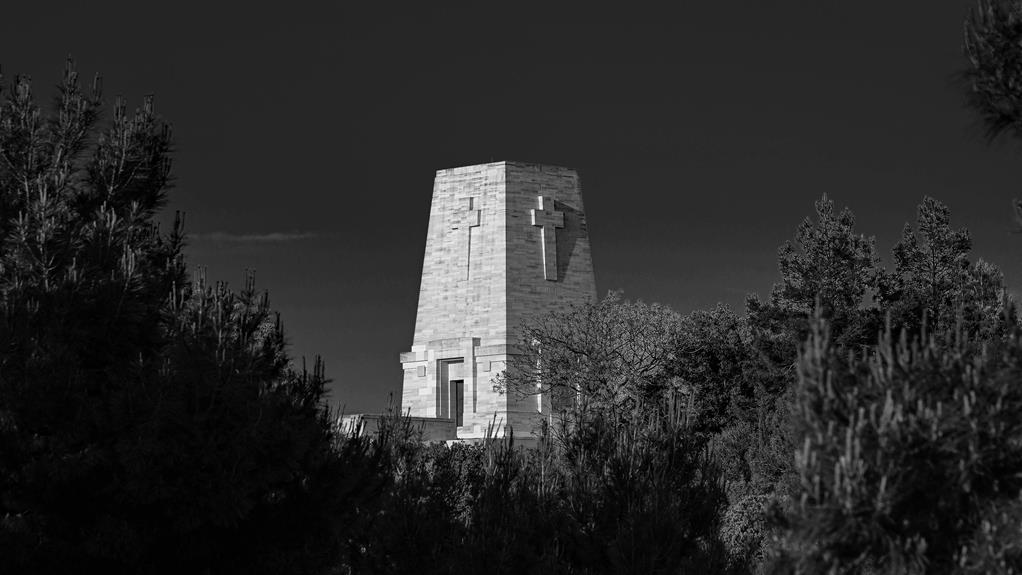Located in the Sunda Strait, Krakatoa, Indonesia, is a volcanic island with a tumultuous past that has left a lasting impact on the world. The 1883 eruption echoed across vast distances, marking one of the most significant volcanic events in recorded history. Today, Krakatoa stands as a beacon of both destruction and resilience, offering a window into the Earth's raw power and the intricate balance of life on a volatile island. As we explore the geological wonders, biodiversity, and conservation efforts surrounding Krakatoa, we are reminded of the ongoing dialogue between nature's forces and human stewardship, leaving us pondering the island's future amidst its turbulent history.
Key Takeaways
- Located in the Sunda Strait between Java and Sumatra.
- Infamous 1883 eruption heard over 3,000 miles away.
- Part of the Pacific Ring of Fire with intense volcanic activity.
- Unique biodiversity with endemic species and ecological adaptations.
- Current attractions include 'Child of Krakatoa' volcano and hiking trails showcasing regrowth.
The Explosive History of Krakatoa
Without a doubt, the explosive history of Krakatoa is a demonstration of the sheer power and volatility of this volcanic island in Indonesia. Krakatoa, located in the Sunda Strait between Java and Sumatra, has a tumultuous past characterized by devastating eruption patterns and intense volcanic activity. The most infamous eruption of Krakatoa occurred in 1883, where the volcanic activity reached cataclysmic levels, resulting in one of the most violent eruptions in recorded history. The eruption was so powerful that it was heard over 3,000 miles away and caused tsunamis that devastated coastal communities.
The volcanic activity of Krakatoa is a subject of great interest to scientists and researchers. The island is part of the Pacific Ring of Fire, a region known for its intense seismic and volcanic activity due to the movement of tectonic plates. Krakatoa's eruptions have showcased a variety of eruption patterns, from effusive eruptions that release lava flows to explosive eruptions that eject ash, rocks, and pyroclastic flows.
Studying the volcanic activity of Krakatoa is vital for understanding the dynamics of volcanic systems and the hazards they pose to nearby populations. By analyzing the eruption patterns and monitoring the volcanic activity of Krakatoa, scientists can better predict and prepare for future eruptions, ultimately contributing to the safety and resilience of the region.
Geological Wonders of Krakatoa
The geological wonders of Krakatoa extend beyond its explosive history, showcasing a diverse range of fascinating features that offer valuable insights into the volcanic processes shaping this dynamic island in Indonesia.
Three Geological Wonders of Krakatoa:
- Formation Processes: Krakatoa's unique geological formations provide a glimpse into the intricate processes that have shaped the island over time. The island's formation can be traced back to the convergence of tectonic plates, resulting in the emergence of volcanic activity that sculpted its landscape.
- Volcanic Activity: Krakatoa's volcanic activity is a prominent geological wonder, with the island being home to several active and dormant volcanoes. These volcanoes offer a window into the intense geological forces at play, with periodic eruptions serving as a reminder of the island's dynamic nature.
- Crater Lakes: One of the intriguing features of Krakatoa is the presence of crater lakes within some of its volcanic calderas. These lakes, formed by the accumulation of water in the craters of dormant volcanoes, provide a serene yet striking contrast to the island's fiery volcanic history.
These geological wonders of Krakatoa not only captivate the imagination but also serve as invaluable sources of information for scientists studying the island's geological evolution. The interplay of formation processes and volcanic activity has created a landscape that continues to awe and inspire visitors from around the world.
Biodiversity on the Volcanic Island
Amidst the volatile geological landscape of Krakatoa lies a rich tapestry of biodiversity waiting to be explored and understood. The unique species that inhabit this volcanic island have developed remarkable ecological adaptations to thrive in such a dynamic environment.
Krakatoa's isolation and ever-changing conditions have led to the evolution of species found nowhere else on Earth. From the endangered Krakatoa mouse to the vibrant Krakatoa orchid, the island boasts a diverse range of flora and fauna that have adapted to the challenging terrain. These unique species showcase the resilience and creativity of nature in the face of adversity.
The ecological adaptations observed on Krakatoa are a demonstration of the remarkable ability of organisms to adjust to extreme conditions. Plants like the Krakatoa fern have developed mechanisms to withstand the high levels of volcanic activity, while animals like the Krakatoa dragonfly have evolved unique behaviors to navigate the turbulent environment. These adaptations not only affirm the survival of species on the island but also provide valuable insights into the process of evolution under extreme circumstances.
Impact of the 1883 Eruption
Following the cataclysmic eruption of 1883, Krakatoa's environmental landscape underwent significant transformations, reshaping the island's ecological dynamics. The impact of the eruption was profound, leaving a lasting imprint on both the environment and the economy of the region.
- Economic Devastation: The eruption of Krakatoa in 1883 resulted in widespread economic devastation. The eruption and its aftermath caused the complete destruction of nearby settlements, leading to the displacement of communities and disrupting local economies that relied on agriculture, fishing, and trade.
- Environmental Impact: The eruption of Krakatoa had a profound impact on the island's environment. The explosion and subsequent tsunamis caused extensive damage to the island's flora and fauna, leading to the loss of biodiversity and altering the ecological balance of the region. The thick layer of ash and pumice that covered the island stifled plant growth and disrupted the habitats of many species.
- Long-Term Consequences: The environmental and economic impacts of the 1883 eruption were felt long after the initial event. The recovery of the island's ecosystem was a slow process, with plant life gradually reclaiming the barren landscapes. The economic recovery was equally challenging, with communities having to rebuild their livelihoods from the ground up in the wake of the devastation.
Visiting Krakatoa Today
In the contemporary era, exploring the volcanic island of Krakatoa provides a unique opportunity to witness the ongoing geological and ecological processes shaped by its tumultuous history. Tourists flock to this site not only for its historical significance but also for its natural beauty and unique attractions. One of the main tourist attractions on Krakatoa is the chance to witness the remnants of the 1883 eruption, such as the iconic 'Child of Krakatoa' volcano that emerged from the sea after the cataclysmic event.
Hiking trails on Krakatoa offer visitors the chance to explore the island's rugged terrain and observe the regrowth of vegetation in the wake of the destructive eruption. These trails provide a firsthand look at the resilience of nature and the gradual recovery of the island's ecosystem. The panoramic views from the hiking trails also offer a glimpse into the sheer power of volcanic activity and its lasting impact on the landscape.
Moreover, Krakatoa's unique position within the Ring of Fire makes it a hotspot for geologists and scientists studying volcanic activity. The island serves as a living laboratory, allowing researchers to observe volcanic processes up close and gain valuable insights into the inner workings of these natural phenomena. Overall, a visit to Krakatoa today provides a blend of historical significance, natural beauty, and scientific intrigue that appeals to a wide range of visitors.
Conservation Efforts and Future Outlook
Conservation initiatives aimed at preserving the ecological integrity of Krakatoa and ensuring the sustainability of its unique ecosystem are pivotal for the long-term resilience of this volcanic island. As we look towards the future, it becomes increasingly important to implement strategies that balance the preservation of Krakatoa's natural beauty with the need for sustainable development.
Here are three key points to keep in mind in the conservation efforts and future outlook for Krakatoa:
- Community Involvement: Engaging local communities in conservation efforts is essential for the success and longevity of any sustainability initiatives on Krakatoa. By involving residents in decision-making processes and educating them on the importance of preserving their environment, a sense of ownership and stewardship can be fostered, leading to more effective protection measures.
- Ecotourism Development: Implementing sustainable ecotourism practices can help generate income for the local community while minimizing negative impacts on the environment. By promoting responsible tourism activities that respect the natural habitats of Krakatoa, economic benefits can be reaped without compromising the island's ecological balance.
- Marine Protection Efforts: Given Krakatoa's location and the richness of its marine biodiversity, establishing marine protected areas and enforcing regulations to prevent overfishing and habitat destruction are critical steps in conserving the island's underwater ecosystems. Collaborating with governmental agencies and conservation organizations can aid in the enforcement of these protective measures, ensuring the long-term health of Krakatoa's marine environment.
Frequently Asked Questions
What Is the Best Time of Year to Visit Krakatoa?
The best time of year to visit a destination is often determined by weather conditions and the ideal season for tourism activities. Understanding the climate patterns and peak tourist seasons can help travelers plan their trips more effectively.
Additionally, knowing the popular attractions and activities available during specific times of the year can enhance the overall experience for visitors seeking adventure and cultural exploration.
Are There Any Active Volcanoes Near Krakatoa?
Volcano monitoring is vital for tracking volcanic activity worldwide. By observing seismic events, gas emissions, and ground deformations, scientists can detect early warning signs of potential eruptions.
Tectonic plate movements play an important role in the formation and activity of volcanoes, as they create the conditions for magma to rise to the surface. Understanding these processes is key to evaluating volcanic hazards and mitigating risks to populations living near active volcanoes.
How Has the Local Community Been Affected by Krakatoa's Eruptions?
The local community residing near volcanic eruptions often faces profound challenges as these natural events can disrupt their livelihoods and infrastructure. The livelihoods of these individuals are intricately tied to the local economy, which can suffer due to the destruction caused by eruptions.
However, despite these adversities, communities often display remarkable resilience in the face of such disasters, coming together to rebuild and support one another in overcoming the impacts of volcanic eruptions.
Can Visitors Go Scuba Diving Near Krakatoa?
Underwater exploration enthusiasts seek diverse locations for encountering marine life. Scuba diving offers a unique opportunity to witness the underwater world firsthand.
Various regions worldwide, renowned for their rich marine biodiversity, attract visitors who are enthusiastic to explore underwater ecosystems.
With proper guidance and equipment, visitors can safely enjoy scuba diving experiences near volcanic islands, discovering the beauty and diversity of marine life in these unique environments.
Are There Any Myths or Legends Associated With Krakatoa?
Legends surrounding Krakatoa are rich in cultural significance, weaving tales that transcend time. These myths often serve as metaphoric mirrors reflecting human emotions, beliefs, and societal values.
Through the lens of folklore, Krakatoa's eruptions become symbolic of nature's power and unpredictability, reminding us of our humble place in the grand scheme of existence.
These narratives not only entertain but also educate, offering insights into the collective psyche of those who revere this iconic landmark.
Conclusion
In summary, Krakatoa stands as a testament to the power and resilience of nature, showcasing the enduring impact of volcanic activity on both the environment and human history. Its explosive history, geological wonders, and rich biodiversity serve as a reminder of the fragile balance between destruction and regeneration in the natural world.
Through conservation efforts and sustainable practices, Krakatoa's future holds the promise of continued exploration and discovery, inviting us to explore further into the mysteries of our planet.


